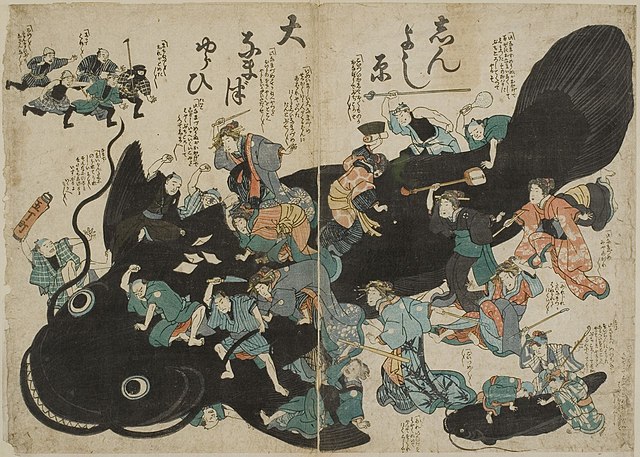The 1855 Edo earthquake , was the third Ansei Great Earthquake, which occurred during the late-Edo period. It occurred after the 1854 Nankai earthquake, which took place about a year prior. The earthquake occurred at 22:00 local time on 11 November. It had an epicenter close to Edo, causing considerable damage in the Kantō region from the shaking and subsequent fires, with a death toll of 7,000–10,000 people and destroyed around 14,000 buildings. The earthquake had a magnitude of 7.0 on the surface wave magnitude scale and reached a maximum intensity of XI (Extreme) on the Mercalli intensity scale. The earthquake triggered a minor tsunami.
Namazu-e print showing a minor deity (Ebisu) sleeping on the job of keeping Namazu under control, allowing the destruction of Edo, Kashima returns on horseback too late
One of the Namazu-e prints that became common after the earthquake, showing the people attacking Namazu
Edo Castle is a flatland castle that was built in 1457 by Ōta Dōkan in Edo, Toshima District, Musashi Province. In modern times it is part of the Tokyo Imperial Palace in Chiyoda, Tokyo, and is therefore also known as Chiyoda Castle .
Tokugawa Ieyasu established the Tokugawa shogunate there, and it was the residence of the shōgun and the headquarters of the military government during the Edo period (1603–1867) in Japanese history. After the resignation of the shōgun and the Meiji Restoration, it became the Tokyo Imperial Palace. Some moats, walls and ramparts of the castle survive to this day. However, the grounds were more extensive during the Edo period, with Tokyo Station and the Marunouchi section of the city lying within the outermost moat. It also encompassed Kitanomaru Park, the Nippon Budokan Hall and other current landmarks of the surrounding area.
Edo Castle with surrounding residential palaces and moats, from a 17th-century screen painting.
Folding screen depicting scenes of daimyōs attending at Edo Castle in 1847. Hasuike-Tatsumi-Sanjū-yagura is at the center, Kikyō-mon (the inner Sakurada-mon) on the right side. Signs alongside the moat are written with the words "geba" (dismount). The attending daimyōs were required to reduce their number of attendants before entering the inner castle compound. Signs with the family names of each entourage identify them (counting from the right side the first panel) from the
The appearance of the Honmaru and Ninomaru during the Edo period
The main tower (upper right) with the surrounding Honmaru palace, Bairinzaka, Hirakawaguchi gate and Ninomaru (lower part)






